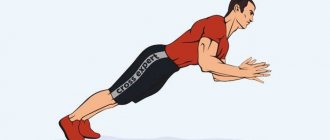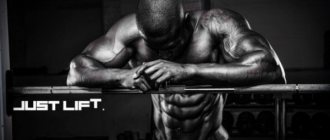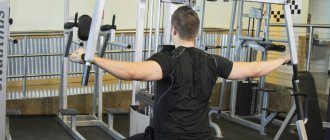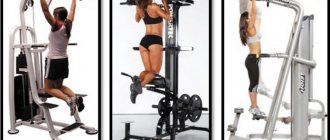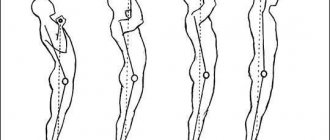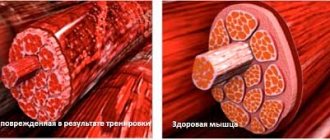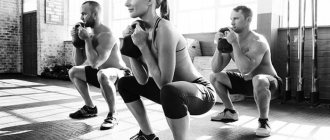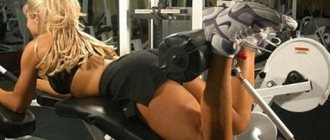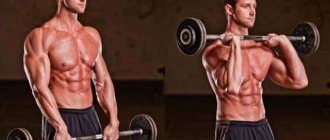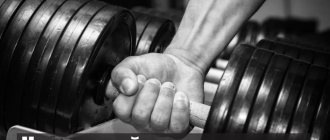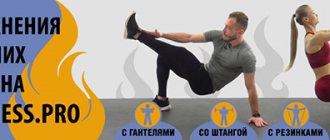The leg extension exercise in the simulator pumps the rectus (frontal) as well as the lateral (side) thigh muscle. Adds detail and definition to the quadriceps. Isolation exercise.
Leg extensions in the simulator draw out the rectus femoris muscle (the front part of the quadriceps), giving it a distinct, convex shape along its entire length, which is especially striking when looking at the thigh from the side. In addition, leg extensions allow you to achieve a clear separation between the rectus and lateralis muscles of the thigh.
The strength of the rectus femoris muscle largely determines your success in all sports that involve jumping and running. Light weight leg extensions are a great way to rehabilitate your knee after an injury.
Leg extensions in the simulator - exercises for leg muscles
Seated leg curls
Sit on the machine seat. Adjust the position of the backrest so that the bottom edge of the seat falls exactly under your knees. The position of the movable roller can also be adjusted. You should rest your ankles on the roller. Lower the support roller onto your knees and engage the lock. Firmly grasp the hand support handles to stabilize your body position. Slowly bend your knees and use your hamstrings to lower the roller downwards. At the end point of the movement, take a short pause and only then “release” the weight. Emphatically slowly extend your knee joints. In the starting position, do not straighten your knees, keep them slightly bent.
NOTES To increase the load on the inner biceps of the thighs, bring the toes of your feet together.
Technique for performing leg curls in a lying machine
The exercise is quite simple, and even a beginner should not have any problems doing it. The whole point of the exercise is shown in one photo below.
Technique for the lying leg curl exercise.
Technique:
- We lie down comfortably on the exercise bench.
- We set the required weight. In the simplest simulators, the weight may not be rearranged, but changed by adding a regular barbell plate.
In some simulators you cannot select the weight - there is no block element, you can only hang weights from the barbell.
- We take the handles of the simulator with our hands.
- We place the shins under the roller. Adjust the moving zone of the machine to suit your height. The cushion should lie between the heel and the calf muscle, in the area of the Achilles tendon.
- Inhale and while holding, bend your knees forcefully, pulling your heels towards your buttocks. Exhale as you pass the most difficult point of the amplitude. At the same time, at the top point you do not need to throw the roller so that it touches you.
- Inhale and slowly lower the roller, feeling the tension and stretch in the back of your thigh.
Technique for the lying leg curl exercise.
The number of repetitions depends on your goal. If you're working on hamstrings or tone, perform 12-15 reps, 4 sets with medium to light weight. To build muscle mass, take a heavier weight and perform 6-8 times for 4-5 approaches.
Shaping the body for summer
Every girl dreams of making her legs and buttocks charming. To do this, you need to gain a sufficient amount of muscle mass and, as a result, make them elastic. Unfortunately, today most women in this regard remain only dreamers, and not embodiments of desires in reality. In fact, pumping up your butt is not at all difficult, the main thing is desire and emphasis on strength training. If modern representatives of the fairer sex were guided by this approach, the number of “tasty” forms on the street would increase sharply.
Butt is very important in summer
Intensive training of the legs and buttocks within one workout is very productive for gaining muscle mass. It is possible that the visible, and perhaps the final desired result, can be observed after a month or two. No one says that training will be easy, but it is worth it, especially since the duration of the training will not take much time.
Lying leg curls: video
Execution technique
- Lie down on the exercise machine. Grasp the special handles with your hands. Secure your legs under the roller(s) of the machine. This will be the starting position.
- Do full leg curls until the roller touches your thighs. As you lift, exhale.
- Return your legs to the starting position. As you lower the roller, inhale.
- Perform 3 sets of 15 reps.
Lying leg curl. Execution technique
Application of the exercise
For whom . Girls and men of any level of training. The exercise is considered quite easy to learn. It is recommended that beginners begin working the back of the thigh with this exercise.
When . Leg curls in the simulator are best performed in the middle or at the end of a leg workout. Before leg curls, do squats with dumbbells and leg extensions in the machine.
How many . The exercise should be done in 3 sets of 15 repetitions (to get into shape). Rest between sets - 90 seconds. If the goal is to gain mass, do 4 sets of 10 repetitions with the maximum load on the machine for you.
Physiology of legs and buttocks
The legs and part of the buttocks are involved almost every day in the normal rhythm of human life. Even when sitting at a desk, the gluteus maximus and minimus muscles are activated, but they are not trained at all. Even repeated repetitions of such static movements will not bring any benefit to the muscles of the buttocks. For significant results, it is not enough to sit; it will not help to pump up a girl’s butt; you need to strain your body in a different way.
Anatomy of the buttocks and legs
You can give your buttocks a little tone using various exercises, one of which is leg abduction and adduction in a standing position. But even a hundredfold repetition will not affect muscle growth at all. Temporary tone is achieved due to the rush of blood to this area and the accumulation of intercellular fluid here. In a few hours the blood will return to normal, the muscles will recover and everything will be as before. As you can see, you won’t be able to gain weight this way, only to maintain tone. You need to pump up your muscles with strength loads with heavy weights and a small number of repetitions. Any workout, of course, should begin with a warm-up.
Short course on the anatomy of the gluteal muscles
This initial stage of training is critical because it prepares the body for subsequent loads, thereby reducing the risk of injury.
In our case, the main attention should be paid to the lower body. In addition to muscles, training involves joints and tendons, which cannot be “exploited” without warming up.
Otherwise, for example, clicking, swelling after exercise, and pain may appear in the joints. So, if you don’t want to take risks, it’s better not to forget about warming up. The content of this stage includes 10-15 minutes of aerobic exercise in the form of jogging, exercise on an exercise bike, ellipse, etc. Then you should do a few lunges or squats to prepare your joints. Running on an incline is especially beneficial for the gluteal muscles. For this purpose, a special treadmill is used in the gym.
Warm up before any strength training
Technique for performing one-leg curls in a lying simulator
If you're trying to correct hamstring asymmetry or put more stress on the muscle, you can perform single-leg curls. In the first case, you can first perform the exercise with one leg, then shift the weight and repeat on the other. In the second, you can do bending alternately.
When bending one leg in the simulator, it is possible to make the hamstrings as symmetrical as possible.
The technique is the same as in the previous case. You can do the required number of repetitions first with one leg and then the other, or perform the lifts one at a time.
This exercise can also be performed standing. As shown below in the video excerpt.
An analogue of the exercise bending one leg while lying down is bending the leg while standing.
Features of the exercise
Leg bending in a lying down machine, or alternatively, sitting and standing (there are also such machines) is one of the most popular exercises in both women's and men's lower body training. This is explained, firstly, by the ease of mastering the technical side of the movement, and secondly, by the opportunity to qualitatively work out the target muscles.
By the way, about muscles. The target muscles when performing calf curls will be:
- Biceps femoris or biceps muscle. It bears the main load.
- Semitendinosus and semimembranosus muscles. They are located closer to the inside of the leg. Just like the biceps femoris, these muscles bend the leg at the knee joint.
- The calf muscles are additionally involved in the work.
Load distribution: biceps femoris, semimembranosus, semitendinosus and gastrocnemius muscles.
As for the place of this exercise in training, it is usually performed, like leg extension, after basic exercises for the legs and buttocks, in particular, after squats or deadlifts. The number of sets and repetitions may vary depending on your goals. As a rule, this is 3-4 approaches of 15-20 times.
- Girls perform this exercise in multiple repetitions with light weight. This approach works for fat burning, allows you to increase muscle tone and draw relief.
- Men do fewer repetitions, but with heavier weight. Thus, the hamstrings increase in volume and muscle strength increases. And this, in turn, not only adds mass to the legs, but also provides significant support when performing basic exercises.
With the correct technique, leg curls on the machine are quite safe and are recommended even for beginners. However, if you have had injuries to your knees or lower spine, be careful.
Classic version of the exercise: in a lying position.
Leg bending while sitting and lying down is practically no different in effect. Choose the position that is most comfortable for you. Doing leg curls while sitting will make it easier for you to breathe because your chest won't be compressed, and lying down will make it easier to control the range of motion of the weight. Also, some athletes do bending alternately with one and the other leg while standing in a special machine. This allows you to better feel the hamstrings. There are many variations and you can always replace one with another.
Bending the legs on the machine while standing.
If you don’t have a simulator at all, you can replace this exercise with leg curls with dumbbells held between your feet. In this case, you lie down on the bench with your stomach.
Other exercise options
In addition to the classic version, there are two more options for performing seated leg extensions:
Effective exercises at home for the whole bodyAbdominal vacuum exercise - instructions on how to do it correctly at home. All the subtleties and secrets from the pros + 100 photos
Exercises for a thin waist and flat stomach. TOP 20 best solutions + instructions with photos and videos!
- Performing the exercise with one leg in a sitting position;
- Perform the exercise with one leg in a semi-standing position.
The second variation of execution is rarely used by trainees. Moreover, very few people realize that different placement of socks can change the amplitude of the load on the muscles.
There are three main positions that are used to work different muscles:
- Classic. We place the socks parallel to each other, that is, evenly. In this position, the quadriceps itself develops.
- The toes are pointed outward, the heels remain in place, we do not separate them. The inner surface of the thigh is pumped.
- Inside. If you put the socks inside, the outer surface of the thigh will be worked out.
The back of the thigh is not involved in the work on this simulator. To work it out, it is better to use exercises known as lying leg curls.
To unload the knee joints and place more stress on the quadriceps, you can try securing your leg at the ankle in the handle from the lower block. In this position, you need to bend your legs one at a time at an angle of 45 degrees.
Exercises for the buttocks
The growth and intensive formation of the gluteal muscles is ensured by the use of free weights when performing exercises in the form of dumbbells and barbells. The best set of exercises for muscle hypertrophy consists of squats, deadlifts, swings, and lunges, naturally with weights.
Squats with dumbbells. Anatomy exercises
Squats
This is perhaps the most difficult exercise on the list; at first, you need to acquire the outside supervision of a partner. Throughout the entire set, from the first to the last repetition, you must keep your foot fully planted on the floor. There is disagreement about the level to which you should squat. They suggest squatting to the maximum, others - only to the level of parallelism between the thigh and the floor. It is known that the first option involves more joints, which is not entirely beneficial for them. However, only you can decide this dispute. As you push your torso up, try to focus the force more on the gluteal muscles than on the front of the thigh. To get results, regular training should be 2-3 times a week. Each time you should perform 5-6 sets of 10-15 repetitions. But if results have already been achieved, one workout per week of the same intensity is enough.
Correct body position during squats
Deadlift
Many people have heard about this exercise, but not everyone knows what it is in detail. Before starting to use a barbell, it is advisable for a beginner to learn the technique using dumbbells. They allow you to provide a natural arch in the lower back throughout the entire approach and keep your shoulder blades retracted longer.
Deadlift. Anatomy exercises
Take dumbbells in your arms extended along your body, squeeze your shoulder blades together, bend at the waist and direct your gaze straight ahead. In this position, move your butt back a little and begin to lower your body vertically down until you feel the muscles in the back of your thigh stretch. Once this is achieved, you can straighten up. The whole point of the exercise lies in these movements.
Deadlifts have a good effect on the buttocks and thighs, helping to quickly build muscles, which prepares them for leg training. The exercise should be performed twice a week with a 4-5X6-10 repetition pattern. To support the results, one-time classes according to the 3-4X10-12 scheme will be quite enough.
Performing deadlifts
There are quite a few variations of this exercise depending on the degree of load on a particular muscle group. As for the gluteal region, the most productive for the muscles will be backward lunges or lunges from a platform (static).
Lunges with dumbbells. Anatomy of exercises
Get a step or other handy elevation 15-20 cm high. Stand with your back to it and throw one leg back so that your toe rests on the edge of the platform. In this position, begin to bend the knee of the supporting leg until the deflection angle reaches 90 degrees, then, due to the tension in the gluteal muscle, return to the starting position, etc. First they work on one leg, then change orientation and start on the other. Training with lunges is carried out twice or thrice a week according to the scheme 2-3X13-15 repetitions
If the goal is to pay more attention to the legs and not the butt, then instead of lunges on the steppe it is better to practice the classic method of execution, which allows you to load the quadriceps more
Butt training. Lunges
Swings with weights
This variation of the swing is designed to load the small flexor muscles. If you work in a gym, then there are probably special machines there, but if not, it’s not scary at all, you can do without such equipment. This is done as follows: attach a weight to your ankle, get on all fours and begin to lift your legs one by one, first 12-15 repetitions for one leg, then for the second. The top point of the lift should be located where the thigh is parallel to the floor, and you need to stay there for a few seconds. The lowering of the leg occurs smoothly. Lift up as if you were driving a nail into the ceiling with your heel. Two classes per week following the 2X20-25 pattern are enough for a good load.
Crossover hip extension
Hip extension in a crossover is performed almost the same as in a simulator. However, performing the exercise in a crossover is better than in a simulator. Since the range of movement of the legs in the crossover is more natural than in the simulator. Thanks to this, there is practically no load on the joints, but the load on the muscles of the buttocks and thighs increases.
However, this technique also has a significant drawback - it is necessary to constantly monitor the position of the body.
In the simulator, the athlete lies down on a cushion, and accordingly he does not need to monitor the position of his back and head. But in a crossover you need to keep your back straight, watch your posture and movements. Because of this, this technique is considered more difficult. Therefore, it is recommended for more experienced athletes to do crossover leg extensions.
Crossover hip extension:
- First you need to prepare the device: install the crossover on the lower blocks, select a handle (it should be one-sided with a loop for arms and legs).
- After everything is ready, you need to place your foot in the handle and rest your hands on the stand of the device. In this position, a slight arch should form in your back. In order for the weight to be distributed correctly, you need to move your head back as far as possible.
- After this, you need to pull the projectile back with a straight leg. Having reached the maximum point, you need to slightly bend your leg at the knee and stay in this position.
- Then you can return to the starting position.
When performing a crossover exercise, you must consider the following:
- It is important to work carefully. Especially when the knee bends, as the foot can slip off the handle and this can lead to a sprain or dislocation.
- You can't rush, you need to work at a moderate speed. It is important to pay more attention to technique rather than speed and number of repetitions.
- During training, you should tense your muscles, this will increase the effectiveness of the exercise.
After this technique has been mastered, you can complicate the activity: use both legs. In the crossover, you can secure both legs and do extensions in turn.
Frontal attack
Leg curls are a single-joint exercise that do not require much energy. This is partly due to the fact that here our feet are not on the floor, and therefore there is no need to maintain balance. For this reason, the stabilizer muscles and muscles of the back of the thighs do not work. And, of course, we are not talking about the coordination work of the hip flexor and extensor muscles. However, extensions are indispensable when you need to form a rounded, straight-forward hip. The fact is that extensions specifically act on the central muscle of the quadriceps, the rectus muscle, and the broad intermedius muscle, which lies underneath it and, during hypertrophy, pushes it outward. After extension, the lateral profile of the thigh naturally becomes wider.
You've probably heard that you need to stretch a muscle before exercising. That's why many leg extension machines have an inclined back. To enhance the stretching effect, it is sometimes pushed back as far as possible, and the body assumes an almost supine position. However, scientific research has shown that in the case of extensions, such a technique not only makes no sense, but is even harmful.
From a stretched position, the quadriceps exhibits less strength. Well, the greatest strength is achieved by the direct position of the body. By the way, this position puts maximum load on the rectus muscle. Compare, the load increases by 42%! If, on the contrary, you lean forward, you will be tempted to cheat. It is sometimes useful, but extension is again not the case at all. When the body is tilted, the trajectory of the tibia is distorted, and this increases the load on the anterior cruciate ligament of the knees with the prospect of injury.
MUSCLE & FITNESS №6-7, 2OO6
Types of exercises and technique
Basic types of flexion exercises
In sports clubs you can most often find three main types of exercise equipment. They differ in the initial position of the body:
- Lying leg curls on a machine . The exercise machine is a horizontal bench. There are hand grips underneath it in front, and a leg bolster at the back. There is a load adjuster located on the side of the bench; you can use it to set the required weight. Starting position: set the desired weight, lie on a bench, place your calves under the roller, and grab the handles with your hands.
- Seated bending . Unlike the first option, here the bench has a back, the handles are located on the sides of the seat or on the upper bolster, one bolster is fixed in front, and the second is at the bottom. Starting position: set the weight, sit on the seat of the exercise machine, press your back tightly against the backrest, place your hips under the upper bolster, and your calves over the lower one.
- Standing bending . The location of the simulator is vertical. Two supports - for the stomach and hips - are located at an angle to each other. There are handles on the top stop, a roller at the bottom, and a weight regulator on the side. The main difference is that the legs only bend alternately. In the first two options, you can bend two legs at once or alternately one leg at a time. Starting position: set the weight, lean against the supports with your hips and stomach, place the calf of the working leg under the roller, the other leg remains the supporting leg.
Some machines do not have a weight adjuster and instead require you to independently hang the weights on pins located on a bolster or on the side of the machine.
Execution technique
Before performing the exercise, you must carefully study the technique of its implementation. Regardless of body position (lying, sitting or standing), recommendations for the correct execution of the exercise will be as follows:
- The body maintains a clearly fixed position throughout the entire approach - the back is straight, a slight arch in the lower back, the abs are tense. Hands hold the handles tightly - this will help maintain the desired position of the body.
- The hips are pressed as close as possible to the bench. In a lying and standing position, the front surface of the thigh is pressed tightly, and the knees slightly extend beyond the border of the bench. In a sitting position, the back surface is pressed against the seat, and the back is pressed against the back of the seat.
- Breathing is not held. When bending, exhale through the mouth, and when returning the legs to their original position, inhale through the nose.
- At the end point of the movement, you need to squeeze the muscles of the hips and buttocks as much as possible.
- The weight must be lowered smoothly - throwing the weight down is unacceptable.
- It is important to remember that the movement is not accomplished by jerking the shin, but by contracting the hamstring muscles.
- The first set is done with little or no weight to prepare the muscles, joints and ligaments for work.
- Changing the position of the foot inward shifts the emphasis to the inner part of the biceps femoris, and when moving the foot outward, the outer part of the muscle will be more involved in the work.
- At the end of the workout or after completing the approaches, perform stretching. Photos of stretching exercises can be found on the Internet.
Lying leg extension
The main thing in this exercise is not to rush, since the load on the knee joints and ligaments is quite strong:
- We lie on our stomachs, placing our feet under the cushion in the ankle area.
- We grab the handles of the simulator and, as it were, pull ourselves up a little towards it. As a result, the knee should be in weight and extend slightly beyond the bench.
- Slowly inhale and bend your shins. You should touch the roller to your buttocks.
- It is better to choose a machine in which the bench is slightly bent, and not perfectly flat. It is in this case that you can stretch the back of the thigh well. On a flat bench, you will have to constantly raise your pelvis, and this can lead to injury.
- There is no need to fully extend your leg at the knee!
Muscle work
When performing leg extensions, the main load falls on the quadriceps muscle of the thigh, that is, the quadriceps. It is the largest muscle in the human body and its main function is to extend the knee joint and straighten the leg. This muscle is partially involved in flexion of the hip joint.
The quadriceps is made up of four smaller muscles:
- Rectus femoris muscle - covers the front of the thigh.
- The intermedius muscle of the thigh is also located in front under the straight line.
- Lateralis muscle - forms the outer side of the thigh.
- Medial – respectively, internal.
Seated leg raises, or as they sometimes say, leg extensions in a machine, allow you to work out all the quadriceps bundles, draw out the relief and improve the shape of your legs. Also, performing this exercise helps improve performance in basic movements, such as the squat or leg press.
Extensions are used as a warm-up before the main leg workout, for pre-exhaustion (at an advanced level) or to finish off the quadriceps after basic exercises. As a basic exercise, it can be given to strengthen muscles for beginners for whom basic squats are still too difficult.
Shin
Front group
The anterior group of muscles of the leg is composed of the tibialis anterior, extensor digitorum longus and extensor pollicis longus. THE ANTERIOR TIBIAL starts from the lateral condyle and diaphysis of the tibia, descends along it to the foot and is attached to the first wedge-shaped and first metatarsal bones. The muscle extends the foot at the ankle joint and supinates it. EXTENSOR DIGITAL LONGUS starts from the upper third of the tibia, fibula and interosseous septum. Divided into four tendons, it extends onto the foot and attaches to the tendon stretch on the back of the second to fifth toes. The muscle extends the toes and pronates the foot. EXTENSOR THIGUS LONGUS originates from the lower two thirds of the fibula and the corresponding part of the interosseous membrane. Its tendon attaches to the base of the nail phalanx of the thumb. The muscle extends both the big toe and the foot and supinates it.
EXERCISES:
SHORT EXTENSION OF THE SHIN OF ONE LEG STANDING
LONG EXTENSION OF THE SHIN OF ONE LEG STANDING
Back group
The posterior and most powerful muscle group of the lower leg consists of two layers. In the superficial layer we will analyze the triceps muscle (it is called the triceps surae), in the deep layer we will analyze the tibialis posterior muscle, the flexor digitorum longus and the flexor pollicis longus. In addition, it is also appropriate here to consider the long and short peroneus muscles: although anatomically they belong to the lateral group of the lower leg, they perform functions similar to the muscles of the posterior group and are trained by the same movements. The TRICEPS MUSCLE, in accordance with its name, has two superficial and one deep heads. The superficial ones form the Gastrocnemius muscle, starting from the epicondyles of the femur. At the bottom, the muscle passes into the Achilles tendon, which attaches to the heel tubercle. The deep head of the triceps forms the SOLEUS muscle, which is wider than the gastrocnemius and is not completely covered by it. It starts from the head and upper third of the body of the fibula and from the diaphysis of the tibia and also passes into the Achilles tendon. The triceps muscle flexes the foot. In addition, the calf also bends the leg at the knee joint. The tibialis posterior muscle originates from the interosseous membrane and the surfaces of the tibia and fibula. Its tendon extends onto the sole, attaches to the scaphoid, three cuneiforms and the bases of the second to fourth metatarsals. The muscle flexes and supinates the foot, and when standing and especially when rising on the toes, it presses the toes to the floor. FLEXOR DIGITAL LONGUS starts from the middle third of the tibia. Its tendon extends to the sole and, dividing into four bundles, is attached to the bases of the four nail phalanges. The muscle flexes the fingers and foot. FLEXOR THIGUS LONGUS originates from the fibula, interosseous membrane and deep layer of the fascia of the leg. Its tendon is attached to the base of the nail phalanx of the thumb. The muscle flexes the big toe and flexes and supinates the foot. The long fibular muscle starts from the head of the fibula and its lateral surface, its tendon passes behind the ankle to the sole, crosses it obliquely and is attached to the bases of the first metatarsal and first cuneiform bones. The muscle pronates and flexes the foot. The short fibular muscle starts from the distal half of the body of the fibula and intercondylar septa, clings to the tuberosity of the fifth metatarsal bone. Pronates, flexes and abducts the foot.
EXERCISES:
STANDING CALF RAISES IN A MACHINE
SINGLE LEG TOE RAISES STANDING
DONKEY TOE RAISES
The name is not very euphonious, but it does not at all hint at the level of your mental abilities, but only imitates the movements of this cute animal. The peculiarity is that here the toes are raised while bending forward. The spinal column is completely unloaded. The weight is placed on the sacrum: it can be either the support of a special exercise machine, or a partner sitting on you. And even better is a partner. Working with two girls on your back - what could be more wonderful? For this alone, our “donkey” deserves special gratitude!
SHIN BENDING IN THE INCLINE LEG PRESS MACHINE
SITTING SHIN FLEXION
Previous chapter | Contents | Next chapter
Let's sum it up
- Lying leg curls are the final exercise in training the thigh muscles (in particular, the biceps), as they form relief and strengthen the muscle frame, rather than building up mass.
- Despite the apparent simplicity of the exercise technique, many perform it incorrectly. It is necessary to constantly monitor the position of the body and legs, especially the knees (they should extend slightly beyond the machine bench), and concentrate on working the muscles of the thigh and lower leg.
- Lying leg curls are considered one of the few exercises that effectively train the hamstring muscles.
Execution technique
Let's look at the technique of performing the exercise while lying down. When doing curls while sitting or standing, follow the same principles.
First of all, adjust the machine to your height and leg length. The knee joints should extend beyond the edge of the bench, and the bolster into which you will rest the lower part of your shin should be located a few centimeters above your heel. Everything is simple here - the closer the roller is to the heel, the greater the leverage and the more effective the exercise. You lie down on your stomach at the bend of the bench so that you are comfortable and there is no tension in your lower back.
- Lie down on the machine and place your feet under the bolster. Use your hands to grasp the special handles or the edges of the bench.
- As you exhale, bend your shins, trying to bring the roller as close to your buttocks as possible. The front surface of the thighs is pressed against the bench.
- As you inhale, straighten your shins, gently lowering the weight down. There is no need to fully straighten your knees and relax your hamstrings at the lowest point.
- Repeat as many times as necessary.
https://youtube.com/watch?v=mtuH16KHCuI
You can vary the load in this exercise by changing the position of your toes. By pointing your toes outwards, you will shift the emphasis towards the outer thighs. Bringing them inward - towards the inner.
You can also alternate bending on the machine in a sitting or lying position. If you have an appropriate simulator, you should try to do the exercise while standing, first with one leg, then with the other. The more versatile the muscle work, the better the result you will get.
After your workout, do some stretching. This will help relax the hamstrings and improve blood circulation.
Advantages and benefits of lying leg curls
The main advantage of this exercise is the targeted isolated development of the femoral biceps . After all, in fact, the hamstrings are involved in many exercises: for example, deadlifts or squats. But these exercises are basic, and therefore involve a lot of additional muscles and joints. When bending the legs on the machine, the load is aimed only at the back of the thigh.
So if you need:
- “bomb” the hamstrings at the end of the workout;
- slightly increase this area in volume;
- give relief;
in general, to “tweak” the hamstrings, then this is a suitable exercise.
Leg extension in the simulator
Legs
The leg extension in the simulator is an isolated (single-joint) exercise designed to work the quadriceps. In the exercise, only one joint works - the knee, so the exercise is isolated. Leg extensions in the machine allow you to give your quadriceps a good workout at the end of your leg workout. Athletes who train legs using the principle of pre-fatigue perform it at the beginning of leg training, just like bending legs in a machine. The exercise is also good for warming up and warming up the muscles before squats with a barbell.
Varieties and techniques of leg extension in the simulator
When you turn your toes inward, the outer surface of the quadriceps will work more. When you turn your toes outward, the inner surface of the quadriceps will work more. I don’t advise you to bother yourself with this, especially for beginners. Perform the exercise in the classic version, with your toes parallel to each other, so each head of the quadriceps will receive the proper load.
You can also perform the exercise with each leg alternately. That is, first we worked with one leg, then the other. This execution allows you to better mentally focus on the work of your quadriceps.
To take the starting position, you need to sit on the machine bench, set the required weight and rest your feet on a special roller. After this, you can begin to perform the exercise, straightening and bending your legs to their full amplitude.
Tips for performing leg extensions in the machine
2) Don’t chase weights, concentrate on working your muscles. This is an isolation exercise, so heavy weights will not benefit you. Smoothly extend and bend your legs as you perform the exercise, contracting your quadriceps as much as possible at the top and stretching at the bottom.
3) It is best to rest your feet in the area of the ankle joint, so the load on the quadriceps will be maximum.
5) Do not place your shin under the machine bench to avoid injuring your knee joints. At the lowest point of the amplitude, you need to bend your legs to such a position that an angle of 90 degrees is formed between the lower leg and thigh. If you reduce the angle and move your shins even further under the bench, then the ligaments of the knee joint may not be able to withstand it, this is especially true for athletes working with heavy weights.
6) Hold your legs at the top of the range for 1-2 seconds to achieve peak quadriceps contraction.
7) Use the handles of the machine to ensure that the buttocks and thighs do not come off the machine bench while performing the approach.
What muscles are involved in leg curls in the machine?
As mentioned earlier, leg curls in the simulator are aimed at working the back of the leg. The so-called biceps femoris or biceps femoris. Call the muscle whatever you like. The main thing is that you have an understanding of what it looks like, where it is located and what functions it performs. But the biceps does not receive all the load; there are also assistant muscles.
- Biceps femoris muscle . Is the target muscle that performs 90% of the movement. It is located on the back of the thigh, just below the gluteal muscles. It is called double-headed because it has two beams: long and short. They are both involved in the exercise. Its functions: bending the lower leg, moving the leg back, and turning the toes apart from each other.
- Semitendinosus muscle . It is located on the back of the thigh closer to the inner (medial) edge. It is an assistant muscle that helps bend the lower leg. Its outer edge borders the biceps muscle, and the inner edge borders the semimembranosus muscle. Its functions are the same as the hamstrings, except for turning the toes. She rotates them inward, towards each other
- Semimembranosus femoris muscle . It is located very close to the inner edge of the thigh. Most of it is covered by the semitendinosus muscle. There are three bundles: outer, middle and inner. Main function: the same as the others, but is not involved in turning the toes.
- Calf muscle . The last muscle involved in the movement is the calves. It is located on the back of the lower leg. It has two heads, internal and external. Function: stabilizes the feet during lifting, and also works during leg extension, creating resistance.
These 4 muscles work in this exercise, and it is their development that gives the back of the leg a beautiful shape.
TYPES OF LEG BENDING
Standing leg curl
Perfectly works the very bottom of the back of the thigh and the top of the calf muscle.
The body should be slightly tilted forward, the leg lifting occurs to the extent that the shin is slightly above parallel to the floor (but the roller does not touch the body), at the lower point the leg is slightly bent to maintain the load. It is important that if your body leans back when lifting, reduce the weight and perform the exercise with perfect form.
Leg bending while sitting in a machine
To begin, adjust the machine to the length of your hips and height; your knees should not go beyond the bench.
The lower back and center of the back are pressed tightly against the back, lower the bolsters so that your shins at the lowest point are strictly parallel to the floor, do not place them behind the machine.
